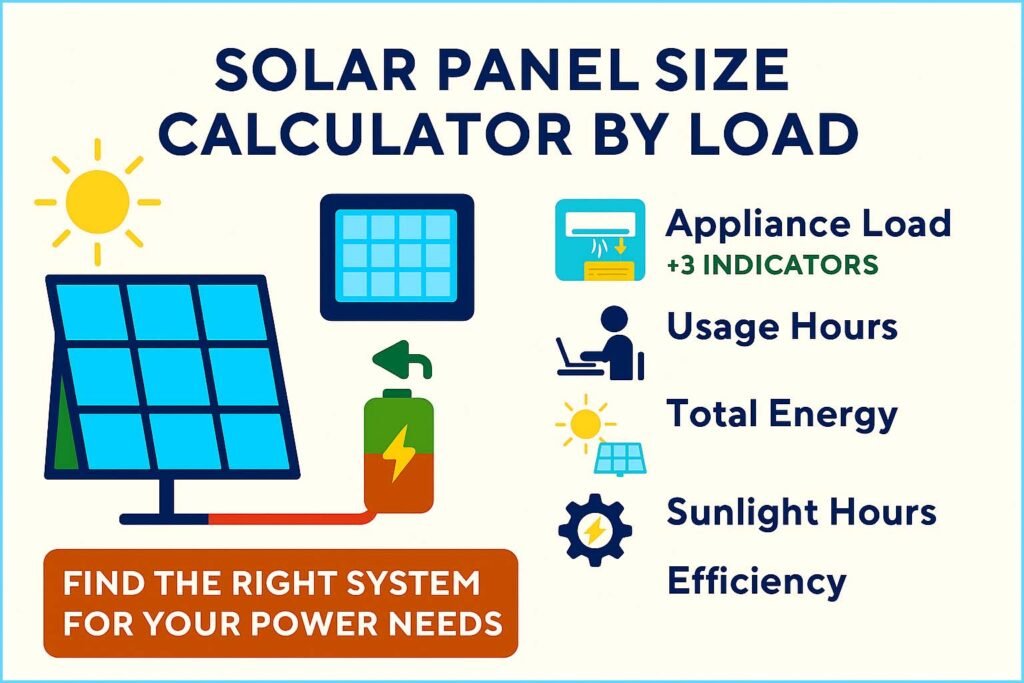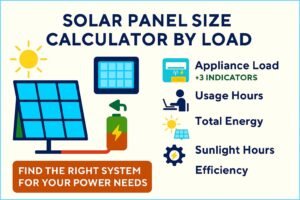Solar Panel Size Calculator by Load – Find the Right System for Your Power Needs
If you’re planning to go solar, one of the first questions that comes to mind is — “What size of solar panel system do I need for my load?” That’s exactly what the Solar Panel Size Calculator by Load helps you determine. Whether you’re setting up a small off-grid cabin, a home backup, or a commercial system, correctly sizing your panels ensures maximum efficiency, lower costs, and a reliable power supply.
Solar panels work best when designed according to the total power consumption or load requirement of your home or business. Choosing the right system is not only about how many panels you can install — it’s about matching your energy usage, backup needs, and location-specific sunlight hours. That’s where this solar panel load calculator comes in. It automates the complex part of solar design, giving you a quick, accurate estimate in just a few clicks.

Table of Contents
Before jumping into how the calculator works, let’s understand why calculating the correct solar panel size by load is so important.
Key Takeaways
- The Solar Panel Size Calculator by Load helps determine the exact size of solar panels required based on your energy consumption.
- It uses your appliance load, usage hours, and location to give a precise solar system estimate.
- This tool can be used for both on-grid and off-grid solar calculator setups.
- Knowing your correct panel size helps reduce installation costs, battery oversizing, and energy waste.
Solar Panel Size Calculator by Load
The Solar Panel Size Calculator by Load is a simple yet powerful online tool that estimates how many solar panels you need to generate enough electricity to meet your daily energy needs.
It’s based on the total wattage of the electrical devices you plan to power and the number of hours they are used.
Solar Panel Size Calculator by Load
Estimate the solar panel size required for your home or shop based on appliance load, usage hours, and sunlight availability.
How to Use: Enter the quantity and daily usage hours for each appliance. Add your average sunlight hours and panel wattage. The calculator will estimate the solar panel size and number of panels needed.
To get the most accurate result, you only need three main pieces of information:
- Total load (in watts or kilowatts) — This includes all the electrical appliances you want to run.
- Daily usage (in hours) — How long you typically use these appliances each day.
- Average sunlight hours — The number of effective sunlight hours available in your area.
Once you input these values, the calculator automatically computes the solar panel capacity (in kW) and the number of panels required to meet your daily energy needs.
Use our online tool Solar Charge Controller Sizing Calculator: Important Tool
Why You Need a Solar Panel Load Calculator
Many people underestimate or overestimate their solar system needs. Without proper calculation, you may end up with:
- A smaller system that fails to power your load during peak usage.
- An oversized system that costs more than necessary.
The solar panel load calculator eliminates guesswork. It ensures your system is neither too small nor too large, helping you optimize both cost and performance. For off-grid systems, it’s especially valuable because you must account for storage, inverter losses, and cloudy days.
How the Solar Panel Size Calculator by Load Works
Here’s a simple explanation of how the calculator determines your solar requirements.
Step 1: Calculate Total Load
You begin by entering the wattage of each appliance and the number of hours it operates per day.
| Appliance | Power Rating (W) | Hours per Day | Energy (Wh) |
|---|---|---|---|
| LED Lights | 60 | 5 | 300 |
| Ceiling Fan | 75 | 6 | 450 |
| Refrigerator | 150 | 8 | 1200 |
| Laptop | 100 | 4 | 400 |
| Water Pump | 750 | 1 | 750 |
| Total | 3100 Wh (3.1 kWh) |
This total (3.1 kWh/day) represents your daily energy consumption.
Use our online tool Solar Wire Size Calculator (DC): Best Solar Cable Sizing Tool
Step 2: Account for System Losses
Every solar setup has system losses — mainly due to inverter efficiency and battery charging. Usually, you should add about 30% extra to cover these losses.
So,
Adjusted Energy Requirement = 3.1 × 1.3 = 4.03 kWh/day
Step 3: Use Sunlight Hours
Next, consider the number of sunlight hours in your area. For example, most regions in Pakistan, India, or the Middle East receive around 5 peak sunlight hours per day.
Now,
Solar Panel Capacity Required = 4.03 / 5 = 0.806 kW (≈ 800 Watts)
If you’re using 400W panels:
No. of Panels = 800 / 400 = 2 panels
This means your load of 3.1 kWh/day can be comfortably handled by two 400W panels in ideal sunlight conditions.
Using the Off-Grid Solar Calculator
If you are designing an off-grid solar system, the calculator also includes additional parameters for battery storage and inverter sizing.
For example:
- Battery Capacity (Ah) = (Daily Load × Backup Hours) / (System Voltage × Depth of Discharge)
- Inverter Size (W) = Total Load (W) × 1.25 (to handle surge load)
Use our online tool Generator Size Calculator for Homes in KVA: Best Tool
This ensures that during cloudy days or nighttime, your batteries can supply sufficient backup power.
| Component | Formula | Example (3.1kWh Load, 24V System) | Result |
|---|---|---|---|
| Battery (Ah) | (4.03 × 1000) / (24 × 0.8) | (4030) / (19.2) | 210 Ah |
| Inverter (W) | 3100 × 1.25 | 3875 | 4 kW inverter |
So, for a 3.1 kWh daily load, you’ll need a 4 kW inverter, 210 Ah battery (24V), and 800W solar panels for an off-grid setup.
Benefits of Using the Solar Panel Size Calculator by Load
- Accuracy – You get a precise estimate tailored to your location and consumption.
- Time Saving – No manual math or guesswork.
- Cost Efficiency – Helps you avoid overspending on extra panels or batteries.
- Energy Planning – Perfect for homes, schools, farms, or commercial setups.
- Scalability – You can easily plan future system expansion.
This tool works perfectly for both residential and commercial solar installations, whether you’re off-grid or on-grid.
Factors That Affect Solar Panel Size
Even with a calculator, it’s important to understand the factors that impact system sizing:
- Location – Sunlight hours vary from region to region. Coastal areas may have less solar radiation than deserts or plains.
- Tilt and Orientation – Panels tilted towards the sun at the correct angle produce more power.
- Weather Conditions – Cloudy or rainy regions may require more panels.
- Load Type – Motors and compressors have starting surges, so inverter sizing must accommodate that.
- System Efficiency – High-quality panels and inverters reduce system losses and improve output.
When you use the Solar Panel Size Calculator by Load, it automatically adjusts results based on these parameters if location data is included.
Use our online tool Solar Panel Calculator for Home – Find Your Perfect System Size and Savings
Example Calculation for a Home Setup
Let’s say you want to power the following:
- 10 LED bulbs (10W each)
- 4 ceiling fans (75W each)
- 1 refrigerator (150W)
- 1 TV (120W)
- 1 washing machine (500W, used for 1 hour daily)
Your total load is approximately 1.7 kW. If used for an average of 5 hours/day, your energy need is 8.5 kWh/day.
With 5 sunlight hours, the required solar system capacity is:
8.5 ÷ 5 = 1.7 kW
Including losses (30%):
1.7 × 1.3 = 2.21 kW
That means you need about 6 solar panels of 370W each to meet your home’s daily power requirement.
Why Choose an Off-Grid Solar Calculator
An off-grid solar calculator is perfect for rural areas, farms, or remote setups where grid electricity is unreliable or unavailable. It helps you design a self-sufficient power system with the right panel size, battery capacity, and inverter power.
Unlike on-grid systems that feed excess power back to the grid, an off-grid setup depends entirely on stored solar energy. So accurate sizing is crucial to prevent power shortages at night or during cloudy days.
Tips for Accurate Solar Load Calculation
- List all appliances you intend to use.
- Note their power ratings and usage hours.
- Include future expansion loads like ACs, water pumps, or electric heaters.
- Add a 25–30% buffer to account for system inefficiencies.
- Recalculate seasonally if your power use changes (e.g., air conditioners in summer).
Use our online tool EV Battery Life Calculator – Estimate Your Electric Vehicle Battery Lifespan Accurately
Final Thoughts
The Solar Panel Size Calculator by Load simplifies one of the most important steps in designing a solar power system. It gives you instant, accurate estimates for the number of panels, inverter size, and battery requirements based on your energy consumption.
Whether you’re building a small off-grid solar setup for a cabin or a large-scale commercial system, this calculator saves you time, effort, and costly mistakes. By entering your daily load and sunlight hours, you’ll know exactly how many panels to install to meet your needs efficiently.
Switching to solar is not just about saving money — it’s about achieving energy independence. With the right system size, you can enjoy reliable, clean power all year round.
Follow Us on Social:
Subscribe our Newsletter on Electrical Insights to get the latest updates in Electrical Engineering.
#SolarPanelSizeCalculator, #SolarLoadCalculator, #SolarSystemSizing, #SolarPowerNeeds, #SolarEnergyCalculator, #OffGridSolarSystem, #SolarPanelSetup, #RenewableEnergy, #SolarInstallation, #SolarSystemDesign, #HomeSolarPower, #SolarCalculatorTool, #GreenEnergy, #SolarPanelsForHome, #SolarSystemPlanning
Solar Panel Size Calculator by Load – Find the Right System for Your Power Needs : Electrical Engineering Hub

Use our Solar Panel Size Calculator by Load to find the perfect solar system for your home or business. Easily estimate your energy needs, system capacity, and required panel size for reliable, efficient power generation
Price Currency: USD
Operating System: All
Application Category: Web Application
